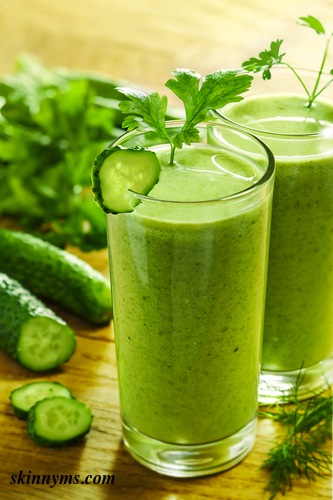Get Juicing!
If you’re looking for an instant natural pick-me-up bursting with vitamins and minerals to nourish your body then get the juicer out.
We all know how important fresh vegetables are in our diet. They contain a living cocktail of essential vitamins, minerals, amino acids, antioxidants and phytonutrients that work together to promote optimal health and protect against disease. Despite this, government surveys indicate that both adults and children struggle to eat anywhere near the recommended 5 a day.
Why Juice?
- Many nutritionists recommend getting at least 6-8 servings of vegetables and 2-3 portions of fruits per day, which very few people actually get.
- Juicing is an easy way to virtually guarantee that you will reach your daily target for fruit and vegetables.
- Juicing encourages you to consume an optimal amount of vegetables in an efficient manner.
- Juicing allows you to absorb nutrients from vegetables / fruits more easily especially if you suffer with poor digestive health
- It provides you with an easy way to add a variety of vegetables to your diet and a fabulous way to try new vegetables
- Juicing can also be targeted towards your own health needs –e.g adding in ginger for digestion or turmeric for inflammation, betacarotene rich sources for healthy eyes etc.
- Juicing is a very powerful tool that you can use to accelerate your progress towards optimal health. Many people start juicing to kick start a new healthier eating programme
- Fresh juices also have remarkable cleansing powers – their high water content is essential for hydrating and cleaning the body of waste and they contain a range of compounds such as citric and malic acid, pectin and chlorophyll known for their ability to absorb fats and toxins from the digestive tract. Green vegetable juices (e.g. broccoli, spinach, kale, wheatgrass) are rich in chlorophyll, and magnesium to support energy levels.
- Optimise nutrients – an easy way to cram in essential nutrients esp if you struggle eating platefuls of vegetables
- Maximise nutrients with minimum of fuss – Some micronutrients become damaged when you heat foods. Cooking and processing food destroys these micronutrients by altering their shape and chemical composition e.g phytonutrients and vitamin C. Juicing ensures high levels of these valuable nutrients
Despite what many people think juicing can be very quick making it an ideal healthy snack – but aim to include protein to stabilise blood sugar and select low GI juices focusing on vegetables.
Not only are fresh juices delicious, they are rapidly digested and absorbed by the body, making them the perfect energy booster.
Unlike commercial juices if you juice yourself they haven’t been damaged by heat. Heating can deplete certain nutrients and enzymes, as can sitting around for days on supermarket shelves.
Fresh juices contain numerous nutrients and plant chemicals known as phytochemicals such as carotenoids and anthocyanins which help support the immune system as well as enzymes essential for digestion. They are also rich in antioxidants, known to protect against degenerative diseases such as cancer and heart disease as well as slow down the signs of ageing.
Juices especially green juices are wonderfully alkaline helping the body maintain its correct acid/alkaline balance. Many people’s diet are highly acidic which may contribute to symptoms such as fatigue and inflammation
Get Juicing
Why don’t we just eat more whole fruit and vegetables? Perhaps because the majority of people struggle to even reach the recommended portions of fruit and vegetables each day. Juicing is a quick and efficient way of obtaining a more concentrated form of the same nutritional ingredients, without eating endless platefuls. For example, it takes about 2kg of whole produce to make between half and one litre of juice. I am not saying you should rely on fresh juices to get all your vegetable intake. Juices alone lack essential dietary fibre and should be drunk to complement a healthy diet, rather than being a substitute for poor eating.
Which Juicer to Use?
There are two main types:
Centrifugal – These are often cheaper (they grate, chop then spin to separate the juice from the pulp). They generally cannot handle a lot of produce in one go and cannot process leafy greens, wheatgrass. Some are very noisy. A spinning basket shreds the fruits and vegetables using a sharp disc, pushing the juice through a fine strainer by centrifugal force. Depending on brand/model, the juice may get foamy and thus oxidize more rapidly – this may deplete the levels of antioxidants present.
Masticating – (Also known as Slow Juicers, Cold Press, Single Gear, or Single Auger). Masticating juicers “chew,” or masticate, your produce by grinding (like teeth) and then squeezing the juice out. These are ideal if you really want to maximise the benefits of juicing and like to try an incorporate juices into your diet on a regular basis. Good quality masticating juicers produce a high juice yield and less pulp. As they generates less foam the juices oxidize slower which maximises their nutrient content. These types of juicers can juice most fruits and vegetables including wheatgrass, leafy greens, herbs and berries. While old models used to be harder to clean the modern juicers are now designed to be easy to clean and have minimal preparation time – large shutes mean no cutting up etc.
The Vertical juicers e.g Optimum take up less space and very efficient. These juicers also operate at much lower speeds (65-80 RPM) keeping heat generation to a minimum. The gentle squeezing and crushing action retains maximum amount of nutrients and Juice, as produce is never exposed to heat.
The quality of the juice is directly related to how well the produce is broken down in the machine and the quantity is determined by the pressure or force used to separate the juice from the pulp. This can vary depending on machine type and the ingredients that you are juicing.
Optimum 600: A Vertical Masticating Juicer
- Patented technology
- No food preparation required – takes the whole produce
- Easy to clean and assemble
- No clogging
- Internal cutting in the machine so you don’t have to
- Larger auger to break down fruit and vegetables efficiently
- Perfect for domestic and commerical uses
- Quiet to use
- Vertical – means it takes up less space on the work surface. The more you have your juicer out the more you are likely to use it.
- High Yield of Juice, minimum fuss
Practicalities
- Whatever juicer you buy make sure it is easy to clean and simple to put together – this will make it easier for you to incorporate fresh juices in your diet on a daily basis.
- Does it separate the pulp effectively?
- Whatever you do, you need to clean your juicer immediately after you juice to prevent any remnants from contaminating the juicer with mould growth.
- Choose organic whenever possible. Certain vegetables in particular are high in pesticides – these include: Celery, Spinach, Kale, Collard Greens, Lettuce, Carrots, Cucumber.
- Focus on vegetable juicing – this is to avoid consumption of too much fructose / sugar which can upset blood sugar levels
- If you are new to juicing try vegetables that are easy to digest and light tasting such as celery, fennel, cucumber
- When you are used to the lighter vegetables add in green leafy veg such as romaine lettuce, endive, spinach, kale and herbs e.g coriander and parsley. Cabbage is particularly good for stomach ulcers being rich in vitamin U
- You can also stir in superfoods to juices to optimise nutrients further (e.g spirulina, chlorella, wheatgrass, maca, baobab, acai)
It is best to drink your juice right away, or store it very carefully otherwise the nutrient levels diminish. If you do wish to store it then do the following:
- Put your juice in a glass jar with an airtight lid and fill it to the very top. There should be a minimum amount of air in the jar as the oxygen in air will “oxidize” and damage the juice.
- Purchase a food vacuum pump. You can pour your juice into a pint jar and put the lid on and use the Food Saver to suck out the air in the jar to vacuum pack it.
- Immediately store it in the fridge and consume it when you are ready. It is best to drink it as soon as possible or within 24 hours of juicing.
Watch Your consumption of Fruit Based Juices
A study published in the British Medical Journal foundwhole fruits—particularly blueberries, grapes, prunes and apples—may reduce your risk of type 2 diabetes. Conversely, consumption of fruit juices was associated with greater risk. Those who drank one or more servings of fruit juice each day had a 21 percent higher risk for type 2 diabetes compared to the others. BMJ 2013;347
If using fruit it is best to use low fructose fruits – lemons, limes, cranberries, apricot, raspberries, cantaloupe melon, kiwi, cherries, pineapple, grapefruit and combine with vegetables
Maximising Flavour
You can vary the flavour of juices with a few simple additions
Lemons and Limes: leave the pith on for optimal levels of limonene
Cranberries: packed with phytonutrients, and can help women avoid urinary tract infections. Just a handful will be enough per juice
Fresh ginger: It gives your juice a little “kick”! And, as an added boon, researchers have found that ginger can have dramatic effects on cardiovascular health, including preventing atherosclerosis, lowering cholesterol levels, and preventing the oxidation of low density lipoprotein (LDL).
Coconut: Use chunks or shredded coconut. It adds a delightful flavor and is an excellent source of fat to balance your meal. Coconut has medium-chain triglycerides, which have many health benefits. You can also add coconut water to your juice, which is an excellent natural source of electrolytes, especially potassium.
Cautions
While juicing is incredibly safe and nourishing – high amounts of juice or certain types may not be appropriate for the following:
Pregnant or lactating women (e.g certain greens e.g watercress in concentrated doses may be linked to miscarriages so caution required especially if using certain powdered superfoods)
Children and babies – watch sugar content in particular
Diabetics or those with metabolic syndrome – pure green juices may be tolerated but be careful with juices containing more fruits
Some green juices contain oxalates. People with a history of gallbladder or kidney stones should reduce consumption of these.
It is important to check with your G.P or health practitioner if you have any long term illness or are on medication. Be aware certain juices (grapefruit) interfere with medications

